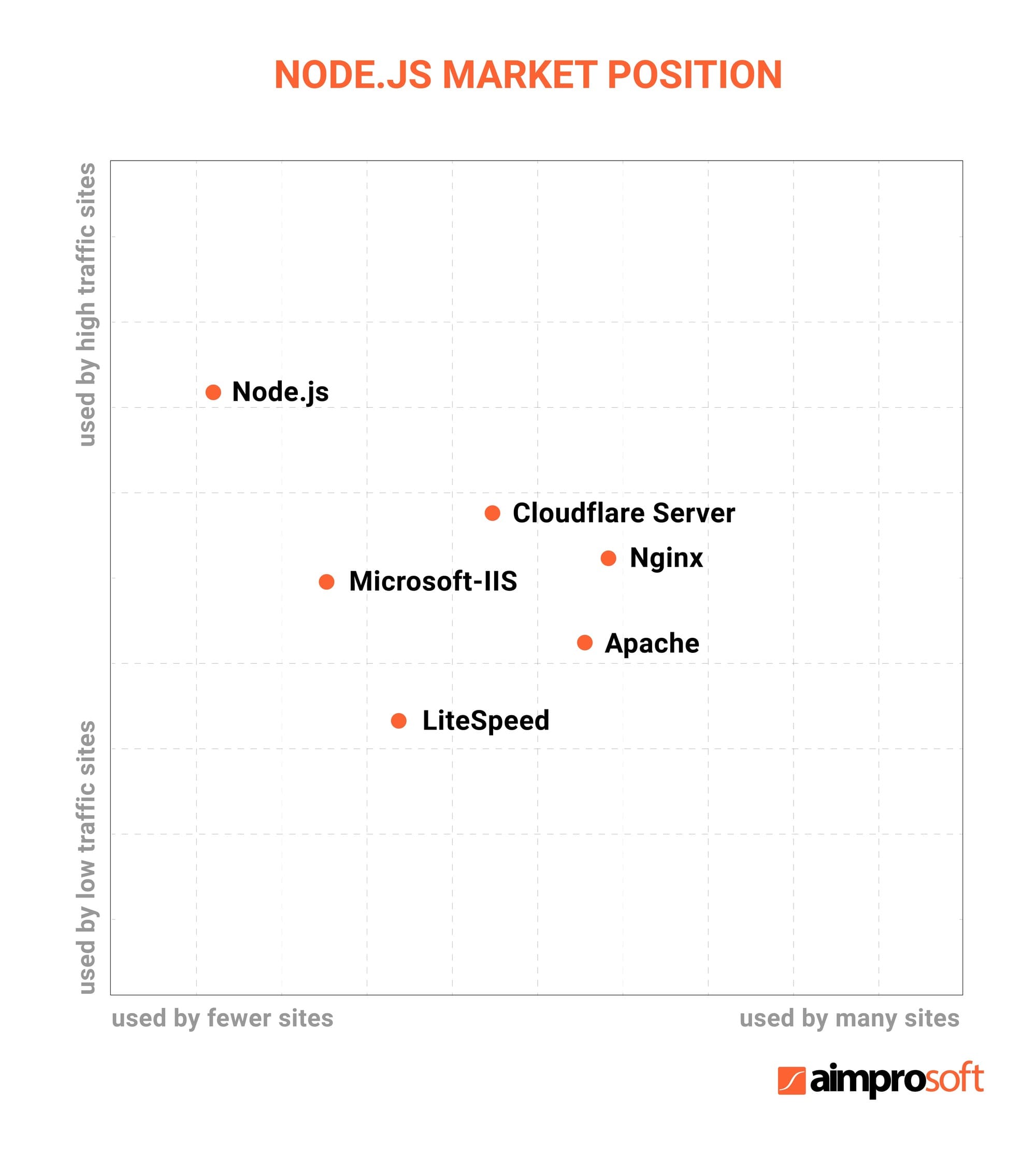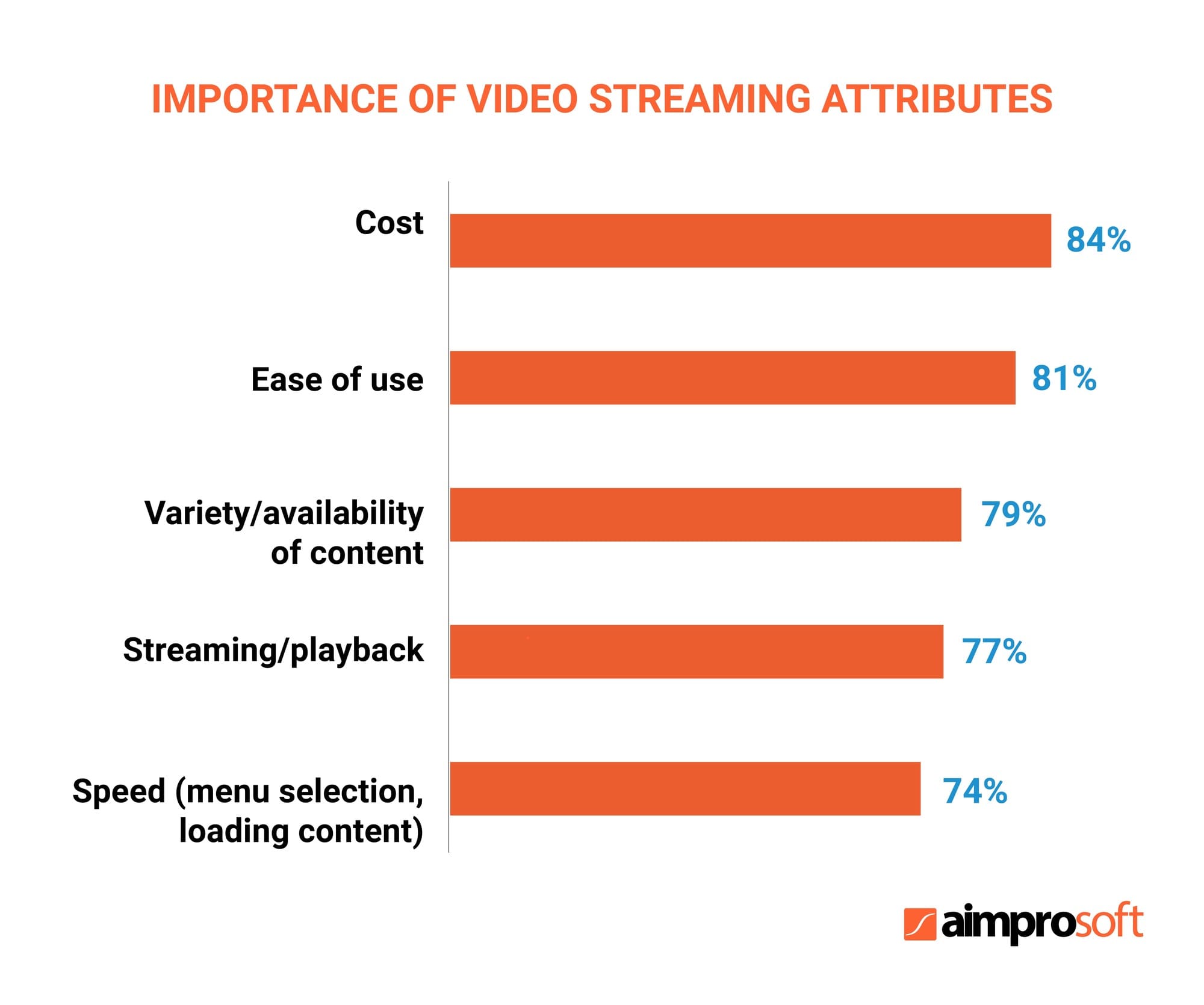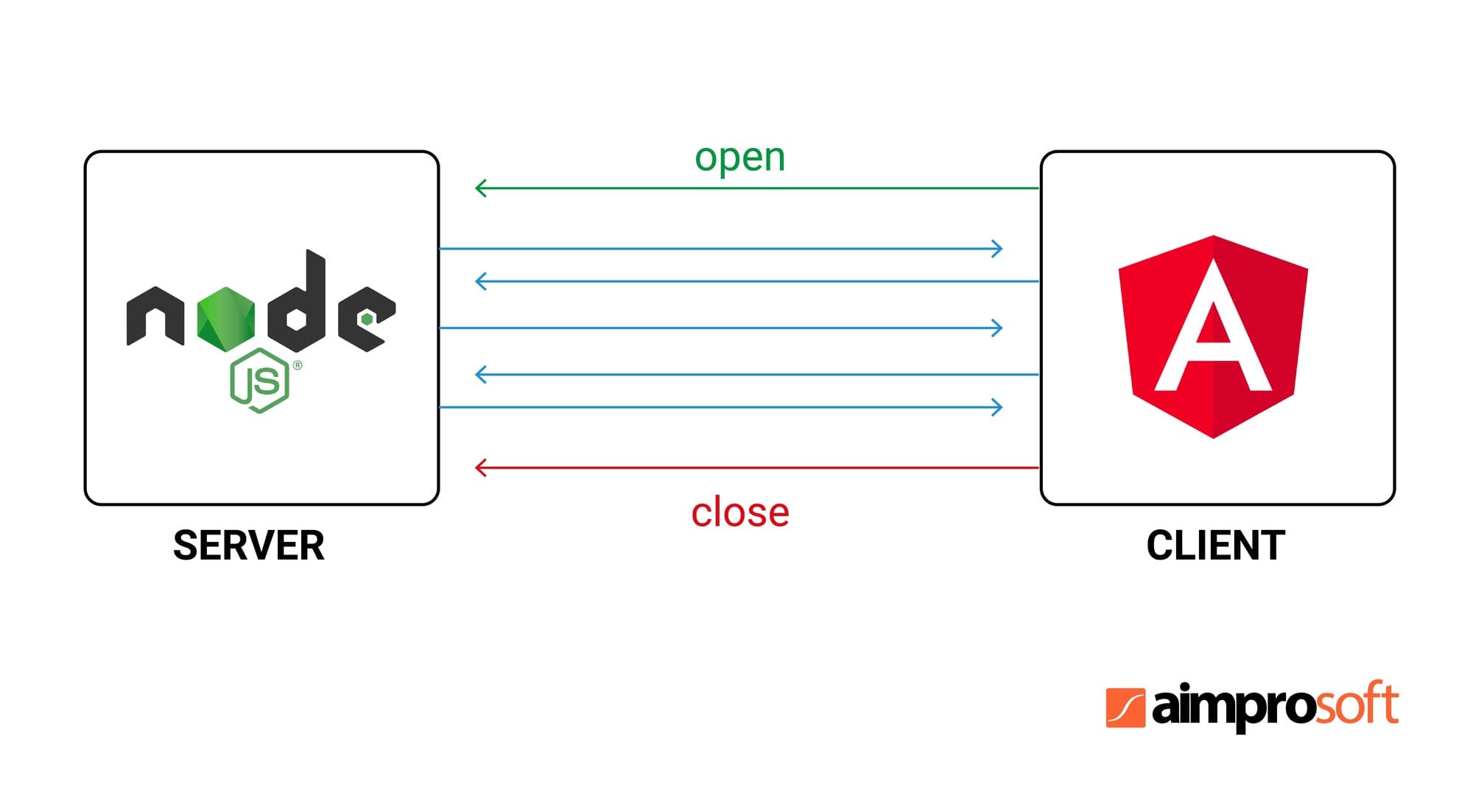How to Build a Real Time Web App with Node.JS as the Most Sought-After Technology

Key takeaways
-
Nothing comes from nothing: a light dive-in into real-time apps in terms of market drivers.
-
The winner takes it all: Netflix is one of the Node js real-time applications examples that overcompeted rivals. Know more about others.
-
How to use such an ambiguous technology? Follow the read to know the most popular use cases backed by Node.js as the core technology.
-
You might be seeking what’s so special about the technical details of Node.js that make it the sought-after technology for real-time applications. You’re on the right path here.
-
At the bottom: find out how to get with a real-time system relying on Aimprosoft’s experience.
In 2000, Reed Hastings, Netflix’s CEO, put forward a proposal to John Antioco, Blockbuster’s CEO, on advertising their brand in the brick-and-mortar stores in exchange for running Blockbuster online. Antioco made a blunder seeing it absolutely absurd and calling into question the business model of Netflix. In 2014, Blockbuster, a US service rental provider of home movies and video games, went out of the game for the reason of being over-competed. John Antioco ignored an upcoming trend for real-time streaming and failed to transform the infrastructure into the streaming-centric one. Netflix, meanwhile, is 44 Emmys winner in 2021 and a $228 billion-dollar company based on market cap.
What is the most competitive advantage of the digital era? The ability to react to situations in a trice at the spot.
With the introduction of an instant chat on mobile by WhatsApp, all of us became excited entered into the new epoche. People swiftly turned to the more comfortable way of communication so that businesses had to hurry up by leveraging it. Many ignited to create a chat app like WhatsApp. And it went from there.
Real-time features such as instant messaging, live streaming, live order status, push notifications, to name a few, have come to be an integral part of our life. Behind the real-time capabilities is progressive technology. According to StackOverflow, two of the three (34%) software developers extensively use Node.js working on the cores of B2B web and mobile applications to enable the right-and-now concept.
To understand how to create a real-time web with Node js, you have to figure out the peculiarities of the technology, cases when you can leverage each, victorious examples of implementation, and criteria that define Node.js as the perfect match for your particular case.
And you’d be right expecting to find in this article famous companies that build their business harnessing Node.js-based real-time capabilities, why they picked on it, use cases by industries, and others to find it the best option for your web app development as a result.
A real-time application as a game-changer
If you decide on the real-time app, you must have been one of those who appreciate time over money.
Most modern web applications operate in milliseconds. However, there are business tasks with way stricter requirements. At the same time, normally, it is no longer enough to run at a relatively fast speed.
In the modern financial world, robots compete with robots, and often the winner is the one who manages to get ahead of the competitor by a split second – the extra microseconds can cost millions. In telecommunications, ensuring a stable connection often requires guaranteed processing time for each package, regardless of the overall load on the system. Even in high-loaded online games, flash-like determinism becomes vital to ensure fair conditions for all participants.
Telecom is transforming, closing to more real-time performance than previously. Know the reasons in our related post.
Looking from the end-user perspective, we used to live reactively. Even a short delay may ruin the moment. After conquering the stock market trading sector, real-time applications have spread to other industries. People got into the way of naturally using live chats, stories, video calls, and adore so lovely typing indicators. It gets close.
A real-time application (RTA in short) is a software system (web or mobile) that functions within a time frame perceived as immediate or current. Normally, the latency is set as a specified timing constraint equal to a second. In some specific cases (military or industrial sectors), microseconds replaced milliseconds and even are pushed by nanoseconds.
Let’s both agree on the RTA we will go further with. Following is a description of the most common use cases of the B2B and B2C applications.
Is Node.js really worth being the core of the web application?
Decision-making in an instant or a live feed looks appealing to many if not to every business. Performable, powerful, and scalable web applications with a functionality familiar to the customers’ daily routine can address current and predicted business challenges. It is all about Node.js. It is used by at least 25.5 million websites among known (1.5% of all the websites – 1.7 billion) as stated W3Tech.
Let’s have a talk to clear up the requirements.
Contact usNode.js: Library, framework, or programming language?
In fact, Node.js is a runtime environment based on Chrome’s V8 JavaScript engine. First initially released by Ryan Dahl in 2009, the language was enthusiastically accepted by the developer community as a means to rectify the technological break of JavaScript – running only in the web browser. Since that developers could build the server-side in JS as well. Shortly after that, this cross-platform open-source tool was intensively adopted by startups and SMB businesses gradually penetrating the enterprise league.
Drivers of technology choice
The diagram below reflects the market position of Node.js. It is highly in demand among high-traffic websites compared to the web servers traditionally used in the development of real-time applications. If you plan to launch a web application with the potential to have over 5000 visitors simultaneously, your website is categorized as high traffic one.

Here’s another way to think about it. Over the years, Node.js evolved into a robust platform with a strong, vibrant community of developers that create new functionality and use amounts of learning materials. Back in April 2021, Node.js v 16 was released thanks to the mutual efforts of a large cast of community contributors and collaborators. As TechCrunch reported, the Node.js and JS foundations will join their force in straightening support for Node projects to “enhance operational excellence” as the primary goal.
One more pro in the kitty: Netflix got carried away with Node so that they created a FaaS platform NodeQuark, a services container with a “no-ops” aspect, which allows deploying code faster.
Then again, the number of posted Node.js developer jobs and the rate of salary, which is $120k as average per year in North America as the most market in need, better than anything, describes the technology as a commodity.
Impressive, isn’t it? So stick with us here to learn players from the major league who rely on Node to ensure the real-time mode of processes delivering services to their customers.
Iconic examples of Node.js real-time applications in the market
Since six years ago, after Node.js went live, 98% of Fortune 500 companies embraced the technology, according to a survey conducted by The Node.js Foundation. Ecommerce giants Amazon and eBay, social networks Reddit, LinkedIn, and Twitter, a streaming platform Netflix, a payment provider PayPal, a ride-hailing service Uber, and other first-string companies use this programming language. Let’s see in detail why big businesses prefer the relatively new software tool over years-proven ones.
Uber: one of the first Node.js adopters with 2 mln calls/sec
Uber’s initial mission was to provide a connection between passengers and drivers. To build a real-time web app with Node.js turned out to be the best decision for their trip execution engine due to its asynchronous primitives and simple, single-threaded processing. Uber was one of two companies that tried the language from the early beginning to support their real-time features and coped with concurrent connections of a large amount. Node.js is behind the real-time pings from riders and drivers and the mechanism matching them and data observation. This technology is proven for quick and reliable processing of enormous data amounts. Inspection and program change while running and withstanding loads like over 2 million remote procedure calls (RPC) per 1 second is what big players like Uber appreciate.
Twitter: gained extra markets
Twitter’s product line is aimed at gaining revenue, which is pretty logical. To win over the users who choose lightweight apps under 600 kilobytes over heavy 200-megabyte iOS apps, in particular, Twitter launched Twitter Lite. It is a fast and responsive Progressive Web App differing enable to use of Twitter across all browsers and devices with a familiar to mobile view. Behind the architecture is a JS client-side and a simple Node.js server. Fewer data usage results in taking up less storage space, accelerating downloading and Twitter services adoption. Node.js coped with the task, successfully inspiring Twiter’s engineering team to re-write the entire backend of their real-time web application with Node js. Isn’t it a great wayout to make a social media app that is used by millions?

Netflix: streaming 140 mln hours of video to 130 mln of customers
Extremely slow builds and startups, a large legacy application, running on the huge developer machine is not what the world’s famous streaming company needs to be productive. A startup performance was the first-tier priority. The efforts were towards moving the website to a more single-page application instead of rendering each page fully.
Node proved itself allowing Netflix to simplify their working environment with a common language: writing the same code and running it everywhere. Performance with a non-block async improved from 40 minutes of startup time to one minute, which is a precious achievement. Moreover, they could improve their product experience due to scaling A/B tests based on Node.js as well. A rich module ecosystem focused on UI needs looked rather as a bonus. And now the engineering team continues working on the Netflix Node.js infrastructure to handle new functions with stability as the prime focus.
Besides, Groupon appreciates Node for a reduction in page loading time. GoDaddy uses it switching from monolith to modular architecture. eBay made shopping more real-time than ever by ensuring stable live connections to servers. Trello says a good word about Node.js for real-time updates using it at their core. PayPal got their application two times faster with a 33% response from the page.
There are shortlisted prominent examples of real-time applications almost each of us uses almost every day. The reasons for relying on Node vary. Just keep reading to get with uses cases of the technology application.
Node.js in real-time applications: use cases leveraged by businesses at full pelt
To back up this reaffirmation with supporting evidence, let’s take up these uses cases to see the ways for a Nodejs realtime app implementation.
Data streaming affects consumer attitude
Data streaming requires heavy processing to provide a continuous stream of data generated from different sources and devices in various formats. 77% of respondents surveyed by Nielsen admitted the playback quality as the 4th important attribute of streaming.

Streaming applications are about real-time data streams requiring a powerful technology behind them to minimize delays for better user experiences. Correctly chosen technology can lay in customers’ return on investment to increase their satisfactory level from service. Node.js can perform real-time data encoding, which is at the core of videoconferencing, video chats, and video surveillance.
Wireless connectivity as a core of IoT apps
Virtual assistants are going to take on roles predictors in their adulting, which will cause more complicated tasks and software engineering requirements. IoT devices constantly generate myriad data to the application server that collects it with further processing and storing.
Outgoing massive real-time traffic from smart devices (cameras, sensors, trackers, etc.) to software applications requires stable connectivity between endpoints. Such applications belong to the category of intensive bandwidth consumption. So request blockage is crucial for them. Node.js supports Input/Output connectivity without blocking, which is a good solution in such cases.
To get a grip on what the IoT application is with its components, read our article.
Single-page applications: Google and Twitter rely on Node.js
Google is a single-page application. It consists of one page only with all downloaded content initially. Its lightweight is achieved because much work is performed on the backend instead of calling directly to and from the frontend. We’ve already mentioned Twitter that is a SPA as well. It is running smoothly due to the JavaScript+Node.js pair. Node.js frees up the frontend assuming heavy sorting and calls in the backend.
Live monitoring dashboards for the high stakes
Live dashboards are one of the most demanded performance tools among companies willing to keep a finger on the pulse of their business. Interactive data visualizations with real-time insights are automatically updated providing instant access to the critical data. They are expected to provide instant notifications of unusual behavior, detect weak areas, and forecast potential errors. Node.js here comes in handy in event-driven applications, those live dashboards are, with its asynchronous approach to data scaling. The speed of Node.js is reached due to its advanced capability of the event loop.
Solutions for in-depth data analysis are typical examples of live monitoring that can be performed on Node as well. Look how we helped Avora with building analytical systems.
Chatbots with Node.js for affordable brand communication
Chatbots are going to cut business spendings $8 billion of business by 2022, bit by bit forcing out customer service calls. Moreover, it is becoming one of the powerful brand communication channels. To get a quick answer to a query is the prime calling for chatbots. That’s why chatbot companies are gaining popularity day by day. Check it out, a Canadian chatbot provider Ada recently raised $130 million in equity with a $1.2-billion market valuation. Node.js is armed with related tools such as Express.js for creating an API with real-time messages (RTM) support. That means for any realtime web app, Nodejs can become a turning mechanism from a unicorn to a decacorn.
Big Data processing without delays
No one browser is designed to deal with large amounts of data. Their main goal is web surfing. They are limited on the amount of memory for every web page. Massive data in the browser makes users wait. One-minute delay with a frozen browser may frighten off users from your real-time application.
Node.js can break the extensive data behind a buffer into small chunks so that to ensure a smooth flow of data from one endpoint to another. The backpressure helps overcome the problem: the data will be sent again after the queue is finished. Thus, the memory will be freed for the next batch of data.
Scalable and responsive multi-user apps
Around-the-clock running demands extra resources to perform preventive measures against failures. Responsiveness of an application, a majority of concurrent connections, quickly changing content (e.g., online messengers) can be supported by the persistent two-way communication between clients and servers.
For example, WebSockets is a popular library for Node.js commonly favored for a full-duplex connection. It allows building two-way connections pushing data back to the client whenever data changes on the Node.js server. In doing so, the client doesn’t have to request data again. Such an approach makes real-time applications highly responsive and at the same time scalable. Due to the single-threaded model of Node.js multi-users requests are handled easily.
Top tech criteria of Node.js excellence
Speed and performance
Node package manager (in tech circles simply NMP) is why your developers will deliver faster. In other words, NMP is a hub of over 800 000 pre-built libraries that can be handy by developing particular cases. By installing it with the nmp command, software engineers can develop Node js real-time app features faster by reusing ready-made code components instead of building from scratch. It uses a JSON file with metadata of your application (packages and dependencies with the script of the project).
Frameworks help add new functionality to web applications faster instead of building afresh. Popular Node.js frameworks and libraries to speed up application development time:
| Express.js | Koa.js | Meteor.js | Socket.io |
| Nest.js | Sails.js | Total.js | Hapi.js |
| Feather.js | Loopback.js | Adonis.js | Derby.js |
The asynchronous and non-blocking nature of JavaScript allows the code to be speedy, which enhances the entire run-time environment. The base of Google’s V8 JavaScript engine contributes to the performance as well. As a result, you get end-to-end programmable on JavaScript web apps that are, by the way, interoperable, which influence positively the performance.
Microservices
In contrast to a single logical executable architecture, the microservice style fits perfectly with a Node.js lightweight nature and the event-driven I/O model. Microservice-related technologies (Docker, Kubernetes) are widely used by full-stack developers building Node.js web applications. A suite of small services as against monolith structure enables to address user requests to a particular part of the application and respond from there. Such direct communication with lightweight mechanisms, typically an HTTP resource API, makes it possible to build a fast and scalable core for real-time applications.
API Integration process
Since so popular and preferred by the majority, the microservice design of application architecture led to the higher necessity of REST APIs implementation. To make the glue between those individual building blocks (microservices), developers make rules, routines, commands, and protocols. Node.js paired with Express.js outputs RESTful APIs that are a good base for enterprise software projects.
Technologies behind the Node js real-time applications development
Anticipating your question concerning which tools to use while the RTA development this is the part where we want to overview going-with technologies.
Feather.JS and Express.JS frameworks are both open-source. Minimal and flexible Express.js is one of the most popular and has everything necessary for creating single or multi-page web applications. Feather.JS, rarer usable but focused more on real-time performance and is a datastore agnostic tool. It can be a simple data controlling tool based on RESTful resources, sockets, and plugins.
The ‘real time’ existed before WebSockets came along. A WebSocket protocol streamlined achieving the real-time mode, accelerated performance, and replaced workarounds applied to non-real-time technologies typically used. A WebSockets support for JavaScript and Node.js is available across all major browsers. The protocol allows maintaining real-time communications in your real-time application while the connection is open.

TypeScript is a language for application-scale JavaScript development. Due to the strong data typing, it can reduce the time for data validation. It will result in increased app speed, which is an attractive option for those like you looking for a perfect technology for development. Its features enable to extend functionality pretty quickly. What is more, TypeScript can prevent about 15% of the bugs in committed code. According to postmortem analysis, Airbnb could prevent 38% of bugs if they opt for TypeScript in time.
Streams lay at the core of Node.js applications. This concept is not new, but streams in Node.js allow piece-by-piece file reading and content processing beyond the memory. The stream module helps to send data in parallel. There is an API for implementing the stream interface.
Take this list as our recommendation, but stay open to other options. You should know that cloud computing and cloud platforms provide features that can be added to enhance instant data transfer. For example, AWS Lambda or Google Functions are used to strengthen real-time capabilities on Node.js.
Socket.io and Redis are libraries widely used to enhance the power of concurrency. Socket.io works well for instant messaging avoiding HTTP calls. Redis is an in-memory database the most fitted to store cache. It shows incredible operation speed. Their combo provides extra perks for applications with live data transfer.
How to build a real time web app with Node.js
Steps are no different from those of other application development. Just pay attention to their sequence, which is really essential.
- Ascertain if Node.js is what you need for your web application core (hope this overview is of use on this subject).
- Prepare a specification (or wireframes, use stories as a starting point) with agreed features and recorded expectations (you can ask a vendor’s business analyst to do this part).
- Get on with the tech stack to fulfill project development (refers to the accompanying technologies – frameworks, libraries, cloud services, etc.).
- Design on the application architecture with your in-house solution architect or outsourced expert (we offer such an option).
- Start implementing your first MVP functionality covering it by tests and relying on user feedback.
How to go real-time with Aimprosoft by creating a web application with Node.js
Here’s one company’s story: In 2016, a group of hardened marketers teamed up to leverage the power of word of mouth towards boosting brand awareness for small and middle local businesses. It is considered a web application (probably SPA) with fast search based on a scalable architecture. They wanted to keep customers informed about business operation changes in real-time.
A full-stack solution based on Node.js turned out to be there the perfect option.
The client expected to get a local directory to aggregate data about local businesses and manage online listings from other popular Foursquare, Yelp, Yext, Google my Business, and others.
The prime solutions we had to implement were:
- an SEO-friendly directory for enhanced discoverability;
- interactive map;
- live reports showing a presence status of the listing across search engines, directories, voice assistants, aggregators, navigations, etc.;
- interactive analytics;
- other valuable features.
Such projects are large in scope of services. We suggest a dedicated team to deliver the solution accelerating time to market, as the client wanted. Our responsibility covered development efforts with further maintenance and support of the platform.
A scalable backend architecture based on Node.js with a microservice approach helped achieve sustainability during high API traffic with massive peak loads. The JavaScript nature of both frontend and backend positively affected the delivery time and maintenance improvements. Having completed the core features, we continue building up to advanced features with response to the market needs and impetuous business growth.
In particular cases, TypeScript can be a proven supplement in development. For example, we’ve been working on a SaaS solution for service inventory planning since the beginning of 2021, making improvements from the legacy monolith application to a modern fast-operating solution with a TypeScript + React pair. We managed to keep the integrity of the existing capabilities and new features.
That’s how it all happens with us developing a real-time app with Node js. The heart of the matter is that technology and processes used for real-time capabilities implementation continue developing. They are concentrated around the way data is obtained: generation, processing, and delivery. If you have tasks that require real-time operating systems, please get in touch with us to discuss the details.FAQ
Now I will save money, and tomorrow, I may regret choosing the wrong tech stack. Clarify it for me, please.
Even NASA considers that no penny should go to waste. Look, the civilian space program of the U.S. adopted Node.js to design an API-driven enterprise architecture for their JavaScript-heavy applications. Around a 300% reduction in the database, access is achieved apart from money savings. Moreover, they reduced the steps of hardware data processing from 28 to 7 steps. Guess what? Yes, Node.js.
Now users can query that one database for everything, reducing the time to access a comprehensive set of data by about 300 percent
Where can I find Node.js developers?
Clients typically prefer to address software service companies because development is just a part of business as a whole. Nowadays, many know that outsourcing some non-core tasks (core too in some cases) may bring better results because teams with focused expertise are more effective. One won’t have to go very far. Aimprosoft is your best choice when you need to hire offshore Node.js developers to help you get the project off the ground.
Can I move to Node.js if my application is based on Java?
Yes, you can do it. Netflix shifted from the monolith Java application to the real-time web with Node js. There are cases of moving from Go, Python, and similar backend languages. We at Aimprosoft warmly welcome microservices so you can get a new system more performable due to splitting architecture.




